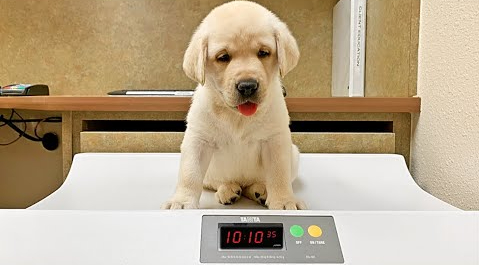All About Labradors: How Many Litters Can a Labrador Have?
How many liters can a labrador have is an important question to consider when planning to add a labrador to your family. Well, I was curious too, so I did some research, and it turns out it varies from dog to dog. Typically, a Labrador can have up to 1-2 litters per year, with each litter containing an average litter size of 6-8 puppies as per the American Kennel Club.
However, it’s important to note that while breeding can be exciting, it’s important to ensure that the dog is healthy and can handle the pregnancy and delivery process. So in this blog post, we will talk about how many litters can a labrador have, the best age for breeding, and other common questions about labradors. Read on and learn more!
The Largest Recorded Litter of Labrador Retrievers
There are many reports of large litters of puppies in the Labradors breed. Anne’s 15 puppies made quite a stir back in 2014 when she gave birth to them. Although it’s not common for a Labrador retriever to have such a large litter, it’s not unheard of. The typical labrador litter sizes are around 6-8 puppies. Anne’s owner, Deborah, was not expecting such a large litter, but she took it all in stride and had the help of family and friends to care for them all.
Fast forward to April 2020, when a Labrador named Bella gave birth to an impressive litter of 14 puppies. This was also quite a surprise for Bella’s owners, who only expected her to have around 8 puppies. These adorable pups quickly captured people’s hearts worldwide, with many people following their journey on social media.
But the biggest litter of Labrador retrievers on record was born to a Neapolitan mastiff called Tia. In November 2004, Tia gave birth to a whopping 24 puppies! This incredible feat earned her a spot in the Guinness World Record for the largest litter of puppies ever born.
The Labrador Breeding Cycle
Before we discuss how many litters a Labrador can have, it’s essential to understand the basics of the breeding cycle.
∎Heat Stage
The heat cycle is the first phase of the breeding cycle in Labs. It is also known as Estrus, and it occurs about every six months in adult female Labs. A female Lab can detect the scent of a male dog several blocks away during this stage. Many Lab owners look for typical signs of Estrus in their dogs, such as swelling of the vulva, discharge, and increased urination frequency. Training your dog during this stage can be challenging, as they may become more irritable and easily distracted. So, keeping them calm and safe inside the house is best to avoid accidents.
∎Mating Stage
Once a female dog is ready to mate, she will become receptive to the presence of male dogs. During this stage, the female will allow the male to mount her, and implantation can occur. Most often, mating occurs between the 10th – 14th days of Estrus. Labradors can get pregnant with a hybrid expecting litter between 5-7 puppies! When a fertilized egg implants in a female’s uterus, her body prepares for pregnancy.
∎Pregnancy Stage
After your Labrador has mated, monitoring her health during pregnancy is essential. The gestation period for Labs is about 63 days. During this stage, look for signs of possible complications such as abdominal swelling, vaginal bleeding, and fever. These could be signs of pyometra, which is a severe bacterial infection of the uterus. Owners should provide their Labs with a healthy diet during this period, and you must watch for conditions such as exercising to a minimum to ensure the safety of the puppies.
Knowing the different stages lets you take necessary precautions to ensure your pet’s reproductive goals are met, and her health is protected.
How Many Litters Can a Labrador Have?
So, how many liters can a labrador have? As mentioned above, each litter contains an average of 6-8 puppies. Various factors can influence a lab’s health and number of litter, including breeding management, reproductive history, and seasonal variations. Furthermore, the environment in which the female animal resides can also impact her well-being and her offspring. I will discuss the factors in detail below:
-
Age:
The age of a Labrador plays a significant role in determining the number of litters they can have. Typically, a Labrador can start breeding from 2 years old and continue until they are around 7-8 years of age. However, some veterinarians may recommend not breeding them after they have reached 5 years old to ensure their health and well-being.
-
Health and Nutrition:
Health and nutrition are critical factors influencing the number of litters a Labrador can have. A healthy and well-nourished dog is more likely to produce healthy litters with more puppies. Malnourished or unhealthy dogs may have a lower litter size and a higher risk of complications during pregnancy and childbirth.
-
Breed Size:
The dog breeds size is another crucial factor to consider when determining the number of litters a Labrador can have. Female Labradors are typically larger than male Labradors, and breeders may prefer to mate a large female with a small male to achieve a litter of healthy puppies. However, this can also depend on the preference and goals of the breeder.
-
Gene Pool Diversity:
The gene pool diversity of a Labrador also influences its capacity to produce healthy litters. Over time, inbreeding can cause genetic issues affecting the litter size and the puppies’ health. Breeding dogs with a diverse gene pool is essential to avoid such issues.
-
Other Factors to Consider:
- Type of breeding: There are two types of breeding – natural breeding and artificial insemination. The outcomes of each can vary.
- Mating frequency: The frequency of mating can impact the health and number of litters a Labrador can have.
- Season: The breeding season for Labradors is between November and February. However, they can mate out of season too.
By understanding these factors, you can better manage your Labrador’s breeding cycles and ensure their well-being.
Responsible Breeding of Your Labrador
Ensuring that your breeding program is ethical and follows appropriate standards is important. I have learned some important lessons and gained invaluable knowledge that I would love to share with you.
✅Conduct Health Screenings and Tests
Before deciding to breed your Labrador, ensure that all breeding dogs undergo complete health screenings and tests. These tests should include hips, elbows, and eyes and diseases common to Labradors such as EIC and CNM. The dogs should be free from these health issues, and not breed any dog with a genetic history of such problems. The health of your dogs should always be a priority.
✅Choose Your Breeding Pair Carefully
Choosing the right breeding pair is critical. It is essential to select complementary dogs, and their strengths and weaknesses balance each other. It is not just a question of selecting the physically appealing dog, but also temperament, intelligence, and trainability. Selecting two dogs with bad temperaments can lead to a bad combination, leading to puppies that make for challenging companions.
✅Give Adequate Care and Nutrition
During pregnancy, your female Labrador will need a balanced and nutritious diet. Nutritional deficiencies can affect the mother and the growth of the puppies, so you should pay extra attention to what you are feeding your dog. It is also essential to provide adequate veterinary care, proper socialization, and adequate training to the puppies to help them develop correctly.
✅Follow Ethical Breeding Practices
Responsible breeding of Labradors is about following ethical practices and ensuring that the breeding population is healthy and sustainable. It means avoiding inbreeding and breeding for profit alone. Your breeding program should be transparent to potential puppy buyers. Every dog breed should have a purpose and improve the breed rather than just for financial gains.
✅Find Appropriate Homes for Your Puppies
Finding homes for your puppies is an essential step in responsible breeding. You should always ensure that the potential owners are suitable and prepared to own a Labrador. They should know the basic requirements of caring for the dog and have the resources to provide it with a healthy and happy life. A good breeder is known for standing behind every puppy they sell and being available for the puppy’s life.
Keep learning about the breed, and always be transparent about the breeding program.
What to Do if Your Labrador Has Multiple Litters in a Year?
As a Labrador owner, you may have experienced the joy of bringing a litter of puppies into the world. However, if your Labrador has multiple litters in a year, it can be concerning, and you might wonder, “What should I do?” So here are some tips on what to do if your dog has multiple litters in a year.
1: Ensure Your Dog Is Healthy and Ready for Breeding
The first step in dealing with multiple litters is to check if your dog is healthy and ready to breed. Consult a veterinarian to confirm your dog is healthy enough for breeding. You will also need to ensure they have adequate nutrition, regular exercise, and proper medical attention.
2: Reduce Breeding
Once you have confirmed that your dog is healthy, it is time to limit the number of litters it produces in a calendar year. While every situation is unique, vets recommend giving female labradors a break of 12 to 18 months between litters. This interval is essential to ensure the dog’s health and well-being are not compromised. Therefore, for example, allowing female labradors to mate twice or thrice a year can be too stressful, resulting in undesirable effects.
3: Spay or Neuter Your Lab
If you no longer intend to breed your Labrador, the best option is to spay or neuter them. Spaying involves the surgical removal of the ovaries and uterus in female dogs. Neutering involves the removal of the testicles in male dogs. Sterilization procedures help prevent pregnancies and safeguard your pet from diseases such as ovarian or testicular cancer in the long term.
4: Plan Ahead
If you want a new litter of puppies in the future, ensure you have a well-thought-out breeding plan. This means you must limit the number of matings your female has in a year. Also, ensure your dog has enough recovery time between litters. Lastly, providing a high-quality environment for your dog will ensure the health of both the mother and the puppies.
5: Get Professional Advice
If multiple litters have already been delivered in a year, professional help is essential. You need professional vet advice to monitor your dog’s and its puppies’ health. The vet can always provide guidance and advice on the health of your puppies. This support saves your puppy’s life, and you have the satisfaction of bringing healthy puppies into the world.
So if you are worried about your labrador having multiple litters in one year, follow the advice above.
Taking Care of a Pregnant Labrador
Preparation is important when expecting a litter of puppies from your Labrador. Ensuring optimal care before and during pregnancy will guarantee the mother’s and her puppies’ health. Here are some tips to help you provide care for your pregnant Labrador:
👉Attend Veterinarian Appointments
The first step in caring for your pregnant Lab is to schedule a veterinarian appointment as soon as you realize she is pregnant. A vet will help you determine the number of puppies your dog is carrying and give you a timeline for your dog’s due date. Your vet will also monitor your dog’s health throughout the pregnancy, enabling them to detect any complications early enough.
👉Diet and Nutrition
Your Labrador’s nutritional needs change during pregnancy, and you need to adjust her diet accordingly. Your dog’s diet should consist of high-quality protein-rich foods, vitamins, and minerals. You should also add calcium and folic acid supplements to strengthen your dog’s bones and improve fetal development.
👉Exercise and Rest
Although exercise is essential for your pregnant Lab, you must ensure she does not exert herself too much. Take your dog for short walks regularly, and avoid strenuous activities like jumping, running, and playing fetch, as they may cause harm to your dog and her puppies. Your dog must also get at least 12-14 hours of rest daily to prevent exhaustion.
👉Prepare for Delivery
Two weeks before your dog’s due date, you should prepare a nesting area and a whelping box for your dog to give birth in. The nesting area should be comfortable and warm and have easy access to food and water. The whelping box should be large enough for your dog and her puppies and should be lined with newspapers, clean towels, or blankets.
Remember, a well-cared-for pregnant dog will give birth to healthy and happy puppies.
Preparing for a Puppy Litter – What to Expect
Below is everything you need to know to be well-equipped for the arrival of your new puppies.
1: Start with Preparation for the Whelping Phase
If you’re dealing with a pregnant dog, prepare for the whelping phase. That usually entails creating a comfortable and peaceful space with soft cushioning or bedding material. Ensure it is warm and devoid of any barriers that could cause accidental mishaps for the mother. Install a lamp or a small heating unit nearby to keep the little ones and their mom warm and cozy.
2: Arrangement for the Puppies
Puppies are small creatures; initially, it is recommendable to have a specially built area as a playpen. It should be in a quiet area as they get acquainted with their new home. The space should be secure and spacious, preferably with a large area to accommodate their toys and toilet area.
3: Stock Up on Puppy Supplies
The fun of owning a puppy includes the hours spent playing, cuddling, and training. However, a range of basic supplies will go a long way toward ensuring puppies grow healthy and happy. Necessary items include a variety of toys, a feeding bowl, waste bags, and a crate or carrier for transportation.
4: Puppy-proof Your Home
It is worth mentioning that having a puppy in your home is equivalent to having a toddler around. Therefore, to be safe, it is essential to prepare. Take time to look around your home for items a curious and playful puppy could get into. Consider getting baby gates to block off certain areas, cover electrical cords and eliminate any home hazards that could harm your puppy.
5: Get Professional Assistance
Finally, prior to the birth of puppies, you may want to seek the services of an experienced veterinarian. They can provide useful advice on diet and healthcare, which is particularly crucial in the first few weeks. Your vet can also evaluate the mother and puppies to ensure all goes well after delivery. They may provide vaccination or a worming schedule based on how many puppies you have and their age.
Knowing what the labrador puppies need and having everything set up before becoming overwhelmed with new responsibilities can make the experience more positive.
Tips for Raising a Large Litter of Labradors
How about raising a large litter of Labradors? Well, raising a large litter is no easy task. Here are some tips on how to do this successfully:
✔️Have a Plan Before the Puppies Arrive
Planning is key to managing a large litter of puppies. Before the puppies arrive, have enough space, food, and supplies to accommodate them. You’ll need to have an area designated for the puppies where they can play and sleep. Ensure the space is clean, comfortable, and safe for the puppies.
✔️Start Socializing Early
Socialization is critical for puppies, especially Labradors, known for their friendly and outgoing personalities. Start socializing your puppies early by exposing them to different people, environments, and sensory experiences. This will help them become well-adjusted and confident adult dogs.
✔️Provide Proper Nutrition
Labradors are energetic and require a balanced diet to meet their nutritional needs. When raising a large litter, ensuring that each puppy gets enough food and nutrition is essential. You’ll need to provide high-quality puppy food rich in protein and healthy fats to help them grow strong and healthy.
✔️Schedule Regular Vet Visits
Regular vet visits are essential for monitoring the health of your puppies. You’ll need to schedule regular check-ups and vaccinations. Don’t hesitate to contact your vet if you notice any signs of illness or unusual behavior.
✔️Develop a Consistent Routine
Puppies thrive on a consistent routine. A consistent routine will help your puppies establish good habits and behaviors. Ensure you have a set schedule for feeding, potty breaks, playtime, and training. This will help your puppies adjust to home life and make training easier.
✔️Be Patient and Enjoy the Process
Raising a litter of puppies can be stressful and overwhelming, but it can also be fun. Take the time to enjoy the process and bond with your puppies. Be patient with the puppies as they go through the process of growing up. You’ll need to be patient with potty training and teaching them basic obedience commands.
Remember that patience, consistency, and proper care are essential to raising happy, healthy, and well-adjusted puppies.
Frequently Asked Questions
At what age can a Labrador have their first litter?
From my experience with my furry friend, waiting until they’re at least 2 years old is essential before breeding. This is because their bodies need time to fully develop and mature before taking on the responsibility of pregnancy and nursing puppies. Plus, waiting until they’re a bit older can ensure healthier and larger litters, which is a win-win situation for you and your pup.
Can a Labrador have litters with different sires?
Yes, a Labrador can have litters with different sires. It is known as ‘outcrossing.’ It’s important to note that even if the puppies are born from different fathers, they will all be considered littermates. So, you must provide proper care and attention to each puppy for them to grow up healthy.
Is it safe for Labradors to have multiple litters?
Hey there! So, I’ve had a couple of Labradors in my life, and as much as I love puppies, it’s not safe for them to have multiple litters. I mean, those mamas go through a lot during pregnancy and birthing, and it can take a toll on their health if they do it over and over again, not to mention the emotional toll it takes on them. They need time to recover and just enjoy being a dog.
Are there any health risks associated with multiple litters in Labradors?
While Labradors are generally healthy dogs, breeding them too often can lead to various health issues, such as joint problems, obesity, and even cancer. As a responsible dog owner, it’s essential to prioritize the health and well-being of your furry friend and consult with a professional veterinarian before deciding to breed your dog.
Are there any genetic considerations to consider when breeding Labradors for multiple litters?
Like humans, dogs can carry hereditary traits that may be passed down to their offspring, potentially leading to health issues or other complications. As a responsible breeder, it’s crucial to closely examine your dogs’ ancestry and assess any potential risks before mating them. This can include checking for common genetic disorders in the breed and ensuring that both parents have been properly health tested.
Can a Labrador have more litters if they have had previous complications during delivery?
It often depends on the individual dog and the severity of the complications. I would recommend consulting a professional veterinarian to evaluate your pup’s health before making any decisions about additional litters. Your vet can help assess potential risks and guide you in making an informed decision.
Final Words
After all the research about how many litters a labrador can have, a female Labrador Retriever can have up to six litters in her lifetime, with an average of six to eight puppies per litter. I can only stress the importance of carefully planning and preparing for a large litter of puppies and providing them with proper care and socialization. Patience, consistency, and proper nutrition are key to raising healthy and well-adjusted pups. Good luck!












